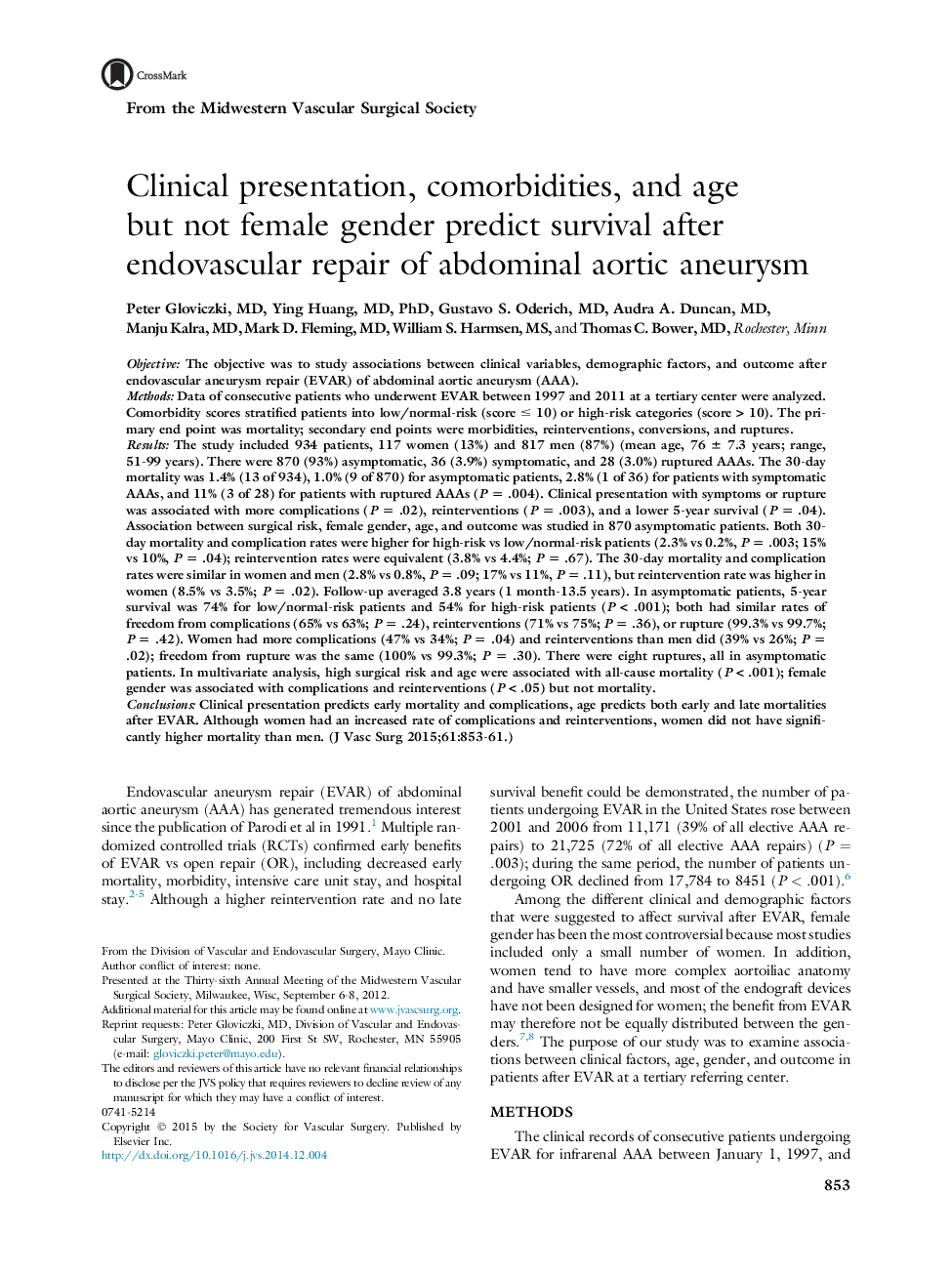| کد مقاله | کد نشریه | سال انتشار | مقاله انگلیسی | نسخه تمام متن |
|---|---|---|---|---|
| 5993324 | 1179815 | 2015 | 11 صفحه PDF | دانلود رایگان |
ObjectiveThe objective was to study associations between clinical variables, demographic factors, and outcome after endovascular aneurysm repair (EVAR) of abdominal aortic aneurysm (AAA).MethodsData of consecutive patients who underwent EVAR between 1997 and 2011 at a tertiary center were analyzed. Comorbidity scores stratified patients into low/normal-risk (score ⤠10) or high-risk categories (score > 10). The primary end point was mortality; secondary end points were morbidities, reinterventions, conversions, and ruptures.ResultsThe study included 934 patients, 117 women (13%) and 817 men (87%) (mean age, 76 ± 7.3 years; range, 51-99 years). There were 870 (93%) asymptomatic, 36 (3.9%) symptomatic, and 28 (3.0%) ruptured AAAs. The 30-day mortality was 1.4% (13 of 934), 1.0% (9 of 870) for asymptomatic patients, 2.8% (1 of 36) for patients with symptomatic AAAs, and 11% (3 of 28) for patients with ruptured AAAs (P = .004). Clinical presentation with symptoms or rupture was associated with more complications (P = .02), reinterventions (P = .003), and a lower 5-year survival (P = .04). Association between surgical risk, female gender, age, and outcome was studied in 870 asymptomatic patients. Both 30-day mortality and complication rates were higher for high-risk vs low/normal-risk patients (2.3% vs 0.2%, P = .003; 15% vs 10%, P = .04); reintervention rates were equivalent (3.8% vs 4.4%; P = .67). The 30-day mortality and complication rates were similar in women and men (2.8% vs 0.8%, P = .09; 17% vs 11%, P = .11), but reintervention rate was higher in women (8.5% vs 3.5%; P = .02). Follow-up averaged 3.8 years (1 month-13.5 years). In asymptomatic patients, 5-year survival was 74% for low/normal-risk patients and 54% for high-risk patients (P < .001); both had similar rates of freedom from complications (65% vs 63%; P = .24), reinterventions (71% vs 75%; P = .36), or rupture (99.3% vs 99.7%; P = .42). Women had more complications (47% vs 34%; P = .04) and reinterventions than men did (39% vs 26%; P = .02); freedom from rupture was the same (100% vs 99.3%; P = .30). There were eight ruptures, all in asymptomatic patients. In multivariate analysis, high surgical risk and age were associated with all-cause mortality (P < .001); female gender was associated with complications and reinterventions (P < .05) but not mortality.ConclusionsClinical presentation predicts early mortality and complications, age predicts both early and late mortalities after EVAR. Although women had an increased rate of complications and reinterventions, women did not have significantly higher mortality than men.
Journal: Journal of Vascular Surgery - Volume 61, Issue 4, April 2015, Pages 853-861.e2
